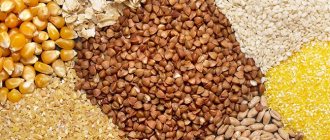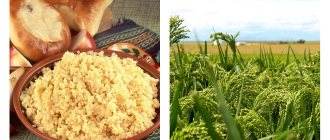Home » Nutrition » Can I eat oats and oatmeal if I have diabetes?
FoodProducts
20.02.2017
44883 Views
Oatmeal is a healthy and tasty breakfast for a great start to the day.
Oatmeal is low in calories and rich in fiber, making it an ideal meal for people watching their weight.
However, it contains a large amount of carbohydrates. For this reason, people suffering from diabetes may doubt the usefulness of this cereal specifically for them.
In this article we will tell you what oatmeal is and whether it is suitable for diabetics. The answer may surprise you a little.
Properties and benefits of oats
This cereal product, in addition to the fiber and carbohydrates already mentioned above, contains both microelements and vitamins, which can be useful for patients dependent on insulin.
Oatmeal is useful for type 2 diabetes, as well as for type 1 diabetes, because it promotes:
- cleansing blood vessels;
- removal of cholesterol from the body;
- regulation of stable blood sugar, since oats contain substances that are involved in the body’s production of insulin and enzymes that break down glucose.
In addition, those who are partial to oatmeal do not suffer from excess weight and, as a rule, do not have liver problems due to the beneficial effect of the cereal on its function.
There are three types of oat products, from the grains of which the outer rough shell, called bran, is removed - these are both whole grains and Hercules, as well as a product obtained by flattening the grains into flakes.
As for the calorie content and content of essential substances, half a cup of cereal, which is approximately 80 grams of product, contains:
- about 300 calories;
- more than 50 grams of carbohydrates;
- 10 to 13 grams of protein;
- fiber – about 8 grams;
- and within 5.5 grams of fat.
Based on these data, oat porridge still has a high carbohydrate content, and if you cook it with the addition of milk, this figure can be increased.
If, for example, you add milk to a serving of oatmeal, the calorie content of the dish increases by more than 70 units, and the presence of carbohydrates also increases in the range from 10 to 15 grams.
Harm or safety: setting priorities
In most respects, oatmeal is beneficial for diabetes. But it's not always safe. Thus, it is not recommended for diabetics to consume instant oatmeal porridge due to the presence of sugar, salt, various flavoring additives, and preservatives in the product.
The product can be harmful for type 2 diabetes mellitus if you exceed the daily intake. You should not eat oatmeal in large portions every day, as this promotes leaching of calcium from the body and impairs the absorption of vitamin D and beneficial minerals into the intestinal walls. As a result, phosphorus-calcium metabolism is disrupted, the structure of bone tissue is destroyed, which can complicate the course of the pathology and cause the development of osteoporosis and other diseases of osteoporosis in diabetics.
The disadvantages of regular use of oat dishes for diabetics also include the factor of frequent occurrence of flatulence. It is due to the presence of plant fiber and starch in the product. To avoid unpleasant consequences, it is recommended to drink oatmeal with plenty of liquid.
But most importantly, oatmeal jelly, decoction, other drinks and cereal dishes can be introduced into the diet only if the course of the disease is smooth. If there is a threat of attacks of hypoglycemia and hypoglycemic coma, systematic use of this product will have to be abandoned.
How do carbohydrates affect sugar after eating?
So is it possible to eat oatmeal if you have diabetes or not?
If you calculate the carbohydrate content in a serving of porridge on a calculator, then in oatmeal it is within 67 percent. This in turn leads to an increase in blood sugar levels.
In a healthy body, glucose is regulated by the production of a hormone such as insulin, which signals its removal from both cells and blood for energy production or storage.
The body of diabetics cannot produce the required amount of insulin on its own, so they are advised to consume as little carbohydrates as possible so as not to contribute to an increase in sugar. Since this threatens complications inherent in diabetes in the form of heart disease, damage to the nervous system, and visual organs.
Carbohydrate foods increase the level of sugar in the body after eating, which aggravates the health problems of diabetics.
Fiber as a sugar regulator
In addition to carbohydrates, oatmeal contains relatively a lot of fiber, which helps regulate substances in the body and, in particular, sugar levels after meals, by reducing the rate of its absorption.
To determine which foods are most suitable for diabetics, they use a classifier or the so-called glycemic index. In this case, it is considered:
- low glycemic index of products if their index is within 55 units or below;
- an average indicator if products have GI values that range from 55 to 69 units;
- and products have a high glycemic index when their value ranges from 70 to 100 units.
So, is it possible to eat rolled oats if you have diabetes? The glycemic index of rolled oats is approximately 55 units.
The glycemic index of oatmeal with water is 40 units. The glycemic index of oatmeal with milk is much higher – about 60 units. Oatmeal has a low glycemic index - only 25 units, while oatmeal has a glycemic index within 65, which is a high GI value.
The increased fiber content in oat products slows down the absorption of both sugar and other substances into the blood.
How to eat oats if you have diabetes?
There is no doubt that oatmeal is healthy for any person. However, oatmeal for type 2 diabetes should be consumed in accordance with certain rules for its preparation and consumption. Only if they are followed does it produce a healing effect.
Oats
It is necessary to use mainly unprocessed oat grains, as well as straw and bran, where the largest amount of fiber is found.
Decoctions from this cereal should be consumed after settling, preferably at room temperature. They are taken, as a rule, half a glass before eating the main meal, the dosage is gradually increased to two or three times a day and no more.
Other benefits of oatmeal
Oatmeal is good for health.
Improving blood lipid composition
Some studies have linked oatmeal consumption to lower total and bad cholesterol levels. On average, this amounts to a moderate decrease of about 9-11 mg/dL (0.25-0.30 mmol/L).
Researchers attribute this effect to the high levels of beta-glucan in oatmeal. They believe it helps the body lower cholesterol levels in two ways.
First, the rate of digestion slows down and the amount of fat and cholesterol absorbed from the intestines decreases.
Second, beta-glucan is known to bind to cholesterol-rich bile acids in the intestine. This prevents the body from absorbing and processing these acids. They simply leave the body along with the stool.
Since high cholesterol increases your risk of heart disease, eating oatmeal can help reduce your risk.
Improved weight control
Oatmeal is great for losing weight. One reason is that oatmeal keeps you feeling full for a long time and reduces the likelihood of overeating.
The high levels of beta-glucan in oatmeal are thought to keep you feeling full longer.
Since beta-gluca is a soluble fiber, it forms a thick, gel-like substance in the stomach. This helps slow down the rate at which food leaves the gastrointestinal tract and keeps you feeling full for a longer time.
In addition, oatmeal is low in calories and rich in nutrients. That is why it is perfect for those losing weight and those who monitor their health.
Improved gastrointestinal health
Oatmeal is loaded with prebiotic soluble fiber, which has the potential to improve the balance of beneficial bacteria in the gastrointestinal tract.
One study found that oatmeal could change the balance of gut bacteria.
However, larger studies are needed to confirm these findings regarding the gastrointestinal health benefits of oatmeal.
Conclusion: Oatmeal has a beneficial effect on health. It helps improve blood lipids and helps control body weight.
Recipes for treatment
Let's look at a few recipes for making oatmeal:
- muesli, i.e. dishes made from cereals that have already been steamed. This food is not so effective for therapeutic effects in diabetes, but it is convenient in its preparation, since it is enough to pour a portion with milk, kefir or juice, and it is ready to eat;
- jelly made from oats or a decoction familiar to many. Such therapeutic nutrition is useful not only for diabetics, but also for patients with disorders of the digestive or metabolic system. To prepare jelly, simply pour boiling water over the crushed cereal grains, steam the portion for a quarter of an hour and consume, adding milk, jam or fruit;
- sprouted oat grains. They should be pre-soaked with cold water and also crushed;
- oat bars. For diabetics, they are very practical for preventing glycemia, since consuming two or three of them replaces a serving of oatmeal. For the road or a snack while working, they are a good type of dietary food.
Oatmeal
Truly healthy oatmeal for type 2 diabetes has two methods of preparation - one, if you take Hercules cereal, and the second, more effective - whole oat grains.
To shorten its preparation time, the product should first be soaked in water, preferably overnight.
Before this, the grains need to be crushed using a blender. Then the cold water is removed, boiling water is added and cooked over low heat until soft.
Medicinal decoctions
As an example, consider two medicinal decoctions:
- decoction with the addition of blueberries. To do this, make a mixture of bean pods, blueberry leaves and sprouted oats. All of them are taken at the rate of two grams for each product. Then this mixture is crushed using a blender. Next, it is poured with boiling water (200-250 ml) and left overnight to infuse. In the morning, filter the broth and drink. Literally half an hour after administration, the level of glucose in the blood decreases significantly;
- The whole grains of this cereal crop should be soaked overnight, and then crushed with a meat grinder. Literally a few spoons of this raw material should be poured with water in the amount of one liter and left to cook for 30-45 minutes over low heat. Allow the broth to cool, and after that it will be ready for consumption. This recipe is most effective for normal liver function.
Bran
As for bran, they are the husk and shell of cereals, which are obtained as a result of grinding or processing grains.
Since they contain the highest amount of fiber, they are beneficial for diabetics. The method of consuming them is simple as they do not require cooking.
To do this, you just need to wash it down with water after taking a spoonful of raw bran. As for the dose, it is gradually increased to three spoons per day.
Buckwheat treats diabetes, oatmeal treats the heart, and semolina...
Russians love to have porridge for breakfast. And that's good - they are much healthier than breakfast cereals. But is it all porridge... It has long been known that porridge contains quite a lot of B vitamins, nicotinic acid, magnesium, potassium, zinc, and selenium. All these are useful and necessary substances.
Expert opinion
Guseva Yulia Alexandrova
Specialized endocrinologist
Buckwheat, oatmeal and barley porridge have a lot of fiber, and this is also great - it prevents constipation. The protein in porridges is average, with the exception of buckwheat. This cereal contains an ideal set of essential amino acids.
“But most of all there is starch in porridges, and this is the real Achilles heel of all cereals,” says Alexander Miller, nutritionist, candidate of medical sciences. - They consist of 70-85% of this substance, which is converted into sweet glucose in the digestive system.
Almost all of it is absorbed into the blood. And the easier the release of glucose from the product, the faster it is absorbed and the more harmful the product: it increases blood sugar more and more strongly promotes the formation of fat. This ultimately leads to obesity and diabetes.
Important! To divide all foods depending on how they increase sugar, doctors came up with a special indicator - GI (glycemic index). The most harmful product is glucose syrup, it has an index of 100.
Everything edible, depending on the GI, is divided into three groups: harmful foods have an index above 70 (they should be consumed as rarely as possible - they powerfully and quickly increase blood glucose), moderate foods have a GI index of 56 to 69, and good foods have a GI index of 56 to 69. — less than 55 (see rating).
Even the best porridges - oatmeal, buckwheat and long grain rice - are, in fact, on the border between healthy and moderate foods. And this means that you shouldn’t overeat on them.
Is love evil?
“In this regard, I was always surprised by the almost universal love of diabetics for buckwheat porridge,” continues Alexander Miller. “They are firmly convinced of its usefulness for their illness, and many simply gorge themselves on it. And this despite the fact that there was no scientific data on the benefits of buckwheat for diabetes.
Attention! But, as Canadian scientists from the University of Manitoba recently found out, there was a grain of truth in such love. Buckwheat turned out to be like a shield and a sword in one bottle. Yes, it contains a lot of starch, which increases blood sugar, but, on the other hand, it contains a substance with the complex name chiro-inositol, which reduces this sugar.
In an experiment, it reduced blood glucose in diabetic rats by almost 20%. True, Canadian scientists are not yet ready to answer the question of how much porridge must be eaten for chiro-inositol to work in humans.
It is possible that it will need to be isolated in the form of an extract and used in higher doses than in buckwheat. There are no answers to these questions yet, but in any case, of all the porridges for diabetics, the most optimal is buckwheat and, perhaps, oatmeal.
Advice! It does not contain a cure for diabetes, like buckwheat, but it contains less starch than other cereals. And plus everything, it contains the so-called beta-glucan. These are special dietary fibers that, when dissolved in the intestines, bind cholesterol.
Their beneficial properties have been proven in forty serious studies. In the US, oatmeal packages were officially allowed to read: “The soluble dietary fiber in oatmeal may reduce the risk of heart disease when consumed as part of a diet low in saturated fat and cholesterol.”
Secrets of decoy
And our favorite porridge is the most harmful. There is a lot of starch in semolina, and its GI is off the charts, but there is little protein, vitamins, minerals and other benefits. Semolina is generally a special grain; in fact, it is a by-product formed during the production of wheat flour.
After grinding, 2% of small fragments of grain always remain, which are only slightly larger than flour dust - this is semolina. Fans of semolina porridge do not realize that there are three types of semolina on sale, which differ slightly in their harmfulness. The most unhealthy and most common is made from soft varieties of wheat.
To identify it, you need to have a higher consumer education: on the packaging it is indicated by the code “brand M” or simply the letter “M”, which tells the buyer little. The best semolina, but not always the tastiest, is made from durum wheat and is designated by the letter “T”.
And semolina with “MT” on the package is neither this nor that, a mixture of soft and hard wheat (the latter should be at least 20%). Why we invented such a label that is incomprehensible to consumers, one can only guess. But what’s more, even this information is often not indicated on the packaging.
Rice is close in “healthiness” to semolina. True, there are several types of really healthy rice. Brown rice is not polished, and it retains the brownish pityriasis shell, in which vitamins B1, B2, E and PP are concentrated. Long grain rice is not bad, it is less overcooked and has a low GI.
Porridge rating
Low GI* (up to 55):
- buckwheat porridge - 54;
- oatmeal - 54;
- long grain rice - 41-55.
Average GI (56-69):
- brown rice - 50-66;
- porridge from regular rice - 55-69 (sometimes up to 80);
- basmati rice - 57;
- Instant long grain rice - 55-75;
- instant oatmeal - 65.
High GI (more than 70):
- semolina porridge - 81.
Note. *The lower the GI (glycemic index), the less the porridge contributes to the development of obesity and diabetes.
Video on the topic
Is oatmeal good for type 2 diabetes? How to prepare an oatmeal decoction that lowers blood glucose levels? Answers in the video:
Diabetes statistics are becoming more alarming and therefore dietary nutrition, like oat-based treatment, is one of the tools for normalizing the lives of insulin-dependent patients.
DIAGEN® - innovation in the treatment of diabetes in humans
- Stabilizes sugar levels for a long time
- Restores insulin production by the pancreas
To learn more…











